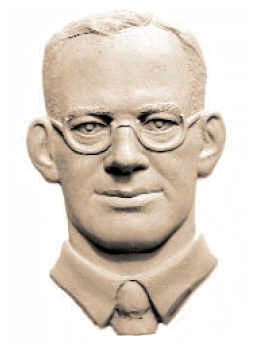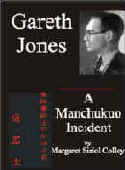Gareth Jones
[bas relief by Oleh Lesiuk]
HOME |
Stop Press |
Complete Soviet Articles & Background Information |
Précis of Gareth's
|
All Published Articles |
BOOKS
|
|
|
|
More Than Grain of Truth(2005) |
|
|
TOPICAL
'Are you Listening NYT?' U.N. Speech - Nov 2009 |
Gareth Recognised at Cambridge - Nov 2009 |
Reporter and the Genocide - Rome, March 2009 |
Order of Freedom Award -Nov 2008 |
Premiere of 'The Living' Documentary Kyiv - Nov 2008 |
Gareth Jones 'Famine' Diaries - Chicago 2008 |
Aberystwyth Memorial Plaque 2006 |
GENERAL
Scholarship Fund |
Site Map |
Links |
Legal Notices |
Sponsored Links |
Contact |
Further Famine Denial by Walter Duranty in The New York Times, April 6, 1933.
Soviet Industry Shows Big Gains
Output of Coal, Oil, Autos, Iron, Locomotives and Tools Is Up 20 to 35 Per Cent
PRODUCTION COSTS CUT
Spring Sowing
Compares Favorably With Last Year, Despite Food Shortages
By WALTER DURANTY
Special Cable to THE NEW YORK TIMES
MOSCOW – April 5. - In the excitement over the Spring sowing campaign and the reports of an increased food shortage, a fact that has been almost overlooked is that the production of coal, pig iron, steel, oil, automobiles, tractors, automotive parts, locomotives and machine tools has increased by 20 to 35 per cent during recent months.
That is the most effective proof that the food shortage as a whole is less grave than was believed – or, if not, at least distribution has greatly improved, which comes to the same thing for practical purposes.
Coal production dropped before Christmas t 160,000 tons a day. Today it is averaging 195,000 tons a day. The pig iron output dropped to 14,000 tons daily in January, and steel to 12,000 tons daily. Today the production of pig iron and steel is 19,000 and 20,000 tons a day, respectively.
Moscow Province, which supplies almost half the nation’s tractor parts, and Leningrad Province, which produces a quarter of the parts, both surpassed the program for the first three months of this year, So did the automotive plants at Nizhni-Novgorad, Kharkov and Moscow, and the huge new ball-bearing plant on the outskirts of Moscow.
There was also a marked reduction in first costs, especially in heavy machine production. All of which goes to show that the recent pessimism-voiced in the Soviet press as self-criticism, no less than by foreigners-was exaggerated and did not take into account the fact that Russian workers are gradually learning to handle their industrial machine, despite delays and obstacles.
It is true, too, that, although the press insists the rate of Spring sowing in the North Caucasus, South Ukraine and Volga regions is much lower than it should be, the total sown area compares favorably with last year, when the sowing was retarded by cold weather.
This year Spring came early throughout the country and the Moscow River is bringing down ice in its Spring flood-an occurrence that is not unusual before the third week of April. While many sections of the South are foul with weeds and while there is a lack of animal traction and, in some areas, apathy and discouragement among the peasants, it is beginning to look as if the sowing prospects are better than was generally expected and the Kremlin has once more proved capable of stimulating its followers to overcome a difficult and apparently critical situation.
RELATED PUBLISHED ARTICLES
CLICK HERE to read Walter Duranty's infamous famine-denial article; 'Russians Hungry, But Not Starving' dated 31 March 1933, in which he personally denigrates Gareth's Jones, for his truthful reporting.
CLICK HERE to read Gareth Jones' published stinging reply to the Editor of the New York Times published on the 13th May 1933
CLICK HERE to read a Published Letter (6th April 1933) to the Editor of the New York Times by reader Katherine Schutcock refuting Duranty's infamous 31 March 1933 'Russians Hungry, But No Famine' article,
© The New York Times. 1931. N.B. The executive editor of The New York Times, Bill Keller, told The Washington Post on October 23 2003, that the newspaper would have no objection if the Pulitzer Prize Board wanted to revoke Mr. Duranty's award. Mr. Keller called Mr. Duranty's work "pretty dreadful. ... It was a parroting of propaganda." It will be taken as read that no royalties are due on this un-authorised reproduction of this article As such they are also perceived, as having no truthful value whatsoever, are only reproduced for academic and educational purposes, not intended to defraud The New York Times of any morally legitimate royalty revenue and are published without financial gain. In any event, the copyright for the above may well only reside, 75 years after its publication with the heirs of Walter Duranty, and with whom we have no personal animosity whatsoever. Nevertheless, any contention of copyright violation may by taken up under the jurisdiction of English Law. My service address for any legal correspondence is: Nigel Linsan Colley, 1, Crown Street, Newark, Nottinghamshire, England, NG24 4UY. Any prosecution will, you can be assured, be defended in the public domain.
[With many thanks to E. Morgan Williams for supplying us with a copy of this article]
|
|
|
|



